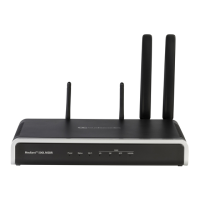User's Manual 67. Configuration Parameters Reference
Version 6.8 901 Mediant 500L MSBR
Parameter Description
'cause' parameter, the 'target' is mapped to the Redirect phone
number and the 'cause' is mapped to the Redirect number reason.
[WaitForBusyTime]
Defines the time (in msec) that the device waits to detect busy and/or
reorder tones. This feature is used for semi-supervised PBX call
transfers (i.e., the LineTransferMode parameter is set to 2).
The valid value range is 0 to 20000 (i.e., 20 sec). The default is 2000
(i.e., 2 sec).
Web/EMS: Line Transfer
Mode
CLI: line-transfer-mode
[LineTransferMode]
Defines the call transfer method used by the device. This parameter is
applicable to FXO call transfer.
[0] None = (Default) IP.
[1] Blind = PBX blind transfer:
Analog (FXO): After receiving a SIP REFER message from the
IP side, the device (FXO) sends a hook-flash to the PBX, dials
the digits (that are received in the Refer-To header), and then
immediately releases the line (i.e., on-hook). The PBX
performs the transfer internally.
[2] Semi Supervised = PBX semi-supervised transfer:
Analog (FXO): After receiving a SIP REFER message from the
IP side, the device sends a hook-flash to the PBX, and then
dials the digits (that are received in the Refer-To header). If no
busy or reorder tones are detected (within the user-defined
interval set by the WaitForBusyTime parameter), the device
completes the call transfer by releasing the line. If these tones
are detected, the transfer is cancelled, the device sends a SIP
NOTIFY message with a failure reason in the NOTIFY body
(such as 486 if busy tone detected), and generates an
additional hook-flash toward the FXO line to restore connection
to the original call.
[3] Supervised = PBX Supervised transfer:
Analog (FXO): After receiving a SIP REFER message from the
IP side, the device sends a hook-flash to the PBX, and then
dials the digits (that are received in the Refer-To header). The
device waits for connection of the transferred call and then
completes the call transfer by releasing the line. If speech is
not detected, the transfer is cancelled, the device sends a SIP
NOTIFY message with a failure reason in the NOTIFY body
(such as 486 if busy tone detected) and generates an
additional hook-flash toward the FXO line to restore connection
SMDI Parameters
Web/EMS: Enable SMDI
[SMDI]
Enables Simplified Message Desk Interface (SMDI) interface on the
device.
[0] Disable = (Default) Normal serial
[1] Enable (Bellcore)
[2] Ericsson MD-110
[3] NEC (ICS)
Notes:
For this parameter to take effect, a device reset is required.
When the RS-232 connection is used for SMDI messages (Serial
SMDI), it cannot be used for other applications, for example, to
access the Command Line Interface (CLI).

